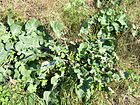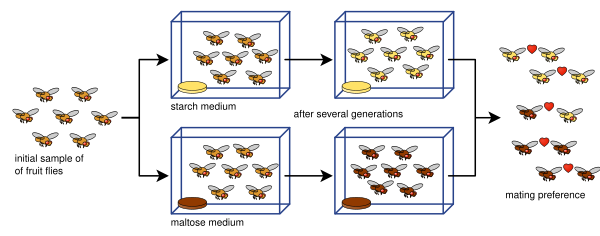Koinophilia
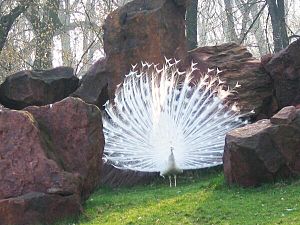
| Part of a series on |
| Evolutionary biology |
|---|
 |
Koinophilia is an evolutionary hypothesis proposing that during sexual selection, animals preferentially seek mates with a minimum of unusual or mutant features, including functionality, appearance and behavior.[1][2][3][4][5][6] Koinophilia intends to explain the clustering of sexual organisms into species and other issues described by Darwin's Dilemma.[3][4][5] The term derives from the Greek, koinos, "common", "that which is shared", and philia, "fondness".
Natural selection causes beneficial inherited features to become more common at the expense of their disadvantageous counterparts. The koinophilia hypothesis proposes that a sexually-reproducing animal would therefore be expected to avoid individuals with rare or unusual features, and to prefer to mate with individuals displaying a predominance of common or average features.[2][3] Mutants with strange, odd or peculiar features would be avoided because most mutations that manifest themselves as changes in appearance, functionality or behavior are disadvantageous.[7] Because it is impossible to judge whether a new mutation is beneficial (or might be advantageous in the unforeseeable future) or not, koinophilic animals avoid them all, at the cost of avoiding the very occasional potentially beneficial mutation.[8] Thus, koinophilia, although not infallible in its ability to distinguish fit from unfit mates, is a good strategy when choosing a mate. A koinophilic choice ensures that offspring are likely to inherit a suite of features and attributes that have served all the members of the species well in the past.[3]
Koinophilia differs from the "like prefers like" mating pattern of assortative mating.[9][10] If like preferred like, leucistic animals (such as white peacocks) would be sexually attracted to one another, and a leucistic subspecies would come into being. Koinophilia predicts that this is unlikely because leucistic animals are attracted to the average in the same way as are all the other members of its species. Since non-leucistic animals are not attracted by leucism, few leucistic individuals find mates, and leucistic lineages will rarely form.
Koinophilia provides simple explanations for the almost universal canalization of sexual creatures into species,[3][4][5] the rarity of transitional forms between species (between both extant and fossil species),[3][4] evolutionary stasis, punctuated equilibria,[3][4][5] and the evolution of cooperation.[11][12] Koinophilia might also contribute to the maintenance of sexual reproduction, preventing its reversion to the much simpler and inherently more advantageous asexual form of reproduction.[13][14]
The koinophilia hypothesis is supported by the findings of Judith Langlois and her co-workers.[2][15][16][17] They found that the average of two human faces was more attractive than either of the faces from which that average was derived.[18] The more faces (of the same gender and age) that were used in the averaging process the more attractive and appealing the average face became.[19] This work into averageness[2][15][16][20] supports koinophilia as an explanation of what constitutes a beautiful face.[17][21][22]
Speciation and punctuated equilibria
Biologists from Darwin onwards [23] have puzzled over how evolution produces species whose adult members look extraordinarily alike, and distinctively different from the members of other species. Lions and leopards are, for instance, both large carnivores that inhabit the same general environment, and hunt much the same prey, but look quite different. The question is why intermediates do not exist.[7][24]

This is the "horizontal" dimension of a two-dimensional problem,[28][29] referring to the almost complete absence of transitional or intermediate forms between present-day species (e.g. between lions, leopards, and cheetahs).[24][30][31]
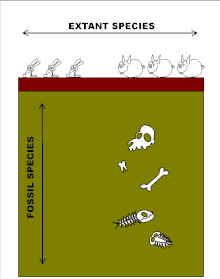
The "vertical" dimension concerns the fossil record. Fossil species are frequently remarkably stable over extremely long periods of geological time, despite continental drift, major climate changes, and mass extinctions.[32][33][34] When a change in form occurs, it tends to be abrupt in geological terms, again producing phenotypic gaps (i.e. an absence of intermediate forms), but now between successive species, which then often co-exist for long periods of time. Thus the fossil record suggests that evolution occurs in bursts, interspersed by long periods of evolutionary stagnation in so-called punctuated equilibria.[32] Why this is so has been an evolutionary enigma ever since Darwin first recognized the problem.[23][34][35]
Koinophilia could explain both the horizontal and vertical manifestations of speciation, and why it, as a general rule, involves the entire external appearance of the animals concerned.[3][4][5] Since koinophilia affects the entire external appearance, the members of an interbreeding group are driven to look alike in every detail.[25][36] Each interbreeding group will rapidly develop its own characteristic appearance.[5] An individual from one group which wanders into another group will consequently be recognized as different, and will be discriminated against during the mating season. Reproductive isolation induced by koinophilia might thus be the first crucial step in the development of, ultimately, physiological, anatomical and behavioral barriers to hybridization, and thus, ultimately, full specieshood. Koinophilia will thereafter defend that species' appearance and behavior against invasion by unusual or unfamiliar forms (which might arise by immigration or mutation), and thus be a paradigm of punctuated equilibria (or the "vertical" aspect of the speciation problem).[3][4]
Evolution under koinophilic conditions

Background
Evolution can be extremely rapid, as shown by the creation of domesticated animals and plants in a very short period of geological time, spanning only a few tens of thousands of years, by humans with little or no knowledge of genetics. Maize, Zea mays, for instance, was created in Mexico in only a few thousand years, starting about 7 000 to 12 000 years ago.[37] This raises the question of why the long term rate of evolution is far slower than is theoretically possible.[7][32][34][38]
Evolution is imposed on species or groups. It is not planned or striven for in some Lamarckist way.[39][40] The mutations on which the process depends are random events, and, except for the "silent mutations" which do not affect the functionality or appearance of the carrier, are thus usually disadvantageous, and their chance of proving to be useful in the future is vanishingly small. Therefore, while a species or group might benefit by being able to adapt to a new environment through the accumulation of a wide range of genetic variation, this is to the detriment of the individuals who have to carry these mutations until a small, unpredictable minority of them ultimately contributes to such an adaptation. Thus, the capability to evolve is a group adaptation, which has been discredited by, among others, George C. Williams,[41] John Maynard Smith[42] and Richard Dawkins.[43][44][45][46] because it is not to the benefit of the individual.
Consequently, sexual individuals would be expected to avoid transmitting mutations to their progeny by avoiding mates with strange or unusual characteristics.[1][2][3][5] Mutations that therefore affect the external appearance and habits of their carriers will seldom be passed on to the next and subsequent generations. They will therefore seldom be tested by natural selection. Evolutionary change in a large population with a wide choice of mates, will, therefore, come to a virtual standstill. The only mutations that can accumulate in a population are ones that have no noticeable effect on the outward appearance and functionality of their bearers (they are thus termed "silent" or "neutral mutations").
Evolutionary process
The restraint koinophilia exerts on phenotypic change suggests that evolution can only occur if mutant mates cannot be avoided as a result of a severe scarcity of potential mates. This is most likely to occur in small restricted communities, such as on small islands, in remote valleys, lakes, river systems, caves,[9] or during periods of glaciation,[47] or following mass extinctions, when sudden bursts of evolution can be expected.[48] Under these circumstances, not only is the choice of mates severely restricted, but population bottlenecks, founder effects, genetic drift and inbreeding cause rapid, random changes in the isolated population's genetic composition.[9] Furthermore, hybridization with a related species trapped in the same isolate might introduce additional genetic changes.[49][50] If an isolated population such as this survives its genetic upheavals, and subsequently expands into an unoccupied niche, or into a niche in which it has an advantage over its competitors, a new species, or subspecies, will have come in being. In geological terms this will be an abrupt event. A resumption of avoiding mutant mates will, thereafter, result, once again, in evolutionary stagnation.
Thus the fossil record of an evolutionary progression typically consists of species that suddenly appear, and ultimately disappear hundreds of thousands or millions of years later, without any change in external appearance.[33][35][48][51] Graphically, these fossil species are represented by horizontal lines, whose lengths depict how long each of them existed. The horizontality of the lines illustrates the unchanging appearance of each of the fossil species depicted on the graph. During each species' existence new species appear at random intervals, each also lasting many hundreds of thousands of years before disappearing without a change in appearance. The degree of relatedness and the lines of descent of these concurrent species is generally impossible to determine. This is illustrated in the following diagram depicting the evolution of modern humans from the time that the hominins separated from the line that led to the evolution of our closest living primate relatives, the chimpanzees.[51]

Phenotypic implications
This proposal, that population bottlenecks are possibly the primary generators of the variation that fuels evolution, predicts that evolution will usually occur in intermittent, relatively large scale morphological steps, interspersed with prolonged periods of evolutionary stagnation,[52] instead of in a continuous series of finely graded changes.[53] However, it makes a further prediction.[4] Darwin emphasized that the shared biologically useless oddities and incongruities that characterize a species are signs of an evolutionary history – something that would not be expected if a bird’s wing, for instance, was engineered de novo, as argued by his detractors.[54] The present model predicts that, in addition to vestiges which reflect an organism’s evolutionary heritage, all the members of a given species will also bear the stamp of their isolationary past – arbitrary, random features, accumulated through founder effects, genetic drift and the other genetic consequences of sexual reproduction in small, isolated communities.[4][55] Thus all lions, African and Asian, have a highly characteristic black tuft of fur at the end of their tails, which is difficult to explain in terms of an adaptation, or as a vestige from an early feline, or more ancient ancestor. The unique, often color- and pattern-rich plumage of each of today’s wide variety of bird species presents a similar evolutionary enigma. This richly varied array of phenotypes is more easily explained as the products of isolates, subsequently defended by koinophilia, than as assemblies of very diverse evolutionary relics, or as sets of uniquely evolved adaptations.
-
The black tuft of fur at the end of this Asiatic lion’s tail is difficult to explain as an evolutionary vestige, or adaptation. Yet it occurs in all lions.
-
The “spectacles” of the spectacled petrel, Procellaria conspicillata, represent an unexplained peculiarity of this species.
-
The unique plumage of the common chaffinch, Fringilla coelebs, unmistakably identifies the species, but its adaptive role is enigmatic.
Evolution of co-operation
Co-operation is any group behavior that benefits the individuals more than if they were to act as independent agents.
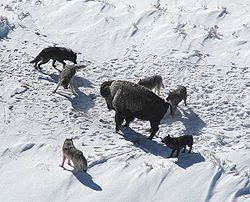
However selfish individuals can exploit the co-operativeness of others by not taking part in the group activity, but still enjoying its benefits. For instance, a selfish individual which does not join the hunting pack and share in its risks, but nevertheless shares in the spoils, has a fitness advantage over the other members of the pack. Thus, although a group of co-operative individuals is fitter than an equivalent group of selfish individuals, selfish individuals interspersed among a community of co-operators are always fitter than their hosts. They will raise, on average, more offspring than their hosts, and will ultimately replace them.[43][44][45][46]
If, however, the selfish individuals are ostracized, and rejected as mates, because of their deviant and unusual behavior, then their evolutionary advantage becomes an evolutionary liability.[3] Co-operation then becomes evolutionarily stable.[11][12]
Effects of diets and environmental conditions

The best-documented creations of new species in the laboratory were performed in the late 1980s. William Rice and G.W. Salt bred fruit flies, Drosophila melanogaster, using a maze with three different choices of habitat, such as light/dark and wet/dry. Each generation was placed into the maze, and the groups of flies that came out of two of the eight exits were set apart to breed with each other in their respective groups. After thirty-five generations, the two groups and their offspring were isolated reproductively because of their strong habitat preferences: they mated only within the areas they preferred, and so did not mate with flies that preferred the other areas.[56] The history of such attempts is described in Rice and Hostert (1993).[57][58]
Diane Dodd used a laboratory experiment to show how reproductive isolation can evolve in Drosophila pseudoobscura fruit flies after several generations by placing them in different media, starch- or maltose-based media.[59]
Dodd's experiment has been easy for many others to replicate, including with other kinds of fruit flies and foods.[60]

The carrion crow (Corvus corone) and hooded crow (Corvus cornix) are two closely related species whose geographical distribution across Europe is illustrated in the accompanying diagram. It is believed that this distribution might have resulted from the glaciation cycles during the Pleistocene, which caused the parent population to split into isolates which subsequently re-expanded their ranges when the climate warmed causing secondary contact.[47][61] Jelmer W. Poelstra and coworkers sequenced almost the entire genomes of both species in populations at varying distances from the contact zone to find that the two species were genetically identical, both in their DNA and in its expression (in the form of RNA), except for the lack of expression of a small portion (<0.28%) of the genome (situated on avian chromosome 18) in the hooded crow, which imparts the lighter plumage coloration on its torso.[47] Thus the two species can viably hybridize, and occasionally do so at the contact zone, but the all-black carrion crows on the one side of the contact zone mate almost exclusively with other all-black carrion crows, while the same occurs among the hooded crows on the other side of the contact zone. It is therefore clear that it is only the outward appearance of the two species that inhibits hybridization.[47][61] The authors attribute this to assortative mating, the advantage of which is not clear, and it would lead to the rapid appearance of streams of new lineages, and possibly even species, through mutual attraction between mutants. Unnikrishnan and Akhila[62] propose, instead, that koinophilia is a more precise explanation for the resistance to hybridization across the contact zone, despite the absence of physiological, anatomical or genetic barriers to such hybridization.
Reception
William B. Miller,[5] in an extensive recent (2013) review of koinophilia theory, notes that while it provides precise explanations for the grouping of sexual animals into species, their unchanging persistence in the fossil record over long periods of time, and the phenotypic gaps between species, both fossil and extant, it represents a major departure from the widely accepted view that beneficial mutations spread, ultimately, to the whole, or some portion of the population (causing it to evolve gene by gene).[63][64] Darwin recognized that this process had no inherent, or inevitable propensity to produce species.[24][23] Instead populations would be in a perpetual state of transition both in time and space.[24][23] They would, at any given moment, consist of individuals with varying numbers of beneficial characteristics that may or may not have reached them from their various points of origin in the population, and neutral features will have a scattering determined by random mechanisms such as genetic drift.[65][66][67]
He also notes that koinophilia provides no explanation as to how the physiological, anatomical and genetic causes of reproductive isolation come about. It is only the behavioral reproductive isolation that is addressed by koinophilia. It is furthermore difficult to see how koinophilia might apply to plants, and certain marine creatures that discharge their gametes into the environment to meet up and fuse, it seems, entirely randomly (within conspecific confines). However, when pollen from several compatible donors is used to pollinate stigmata, the donors typically do not sire equal numbers of seeds.[68] Marshall and Diggle state that the existence of some kind of non-random seed paternity is, in fact, not in question in flowering plants. It is how this occurs that remains unknown. Pollen choice is one of the possibilities,[68] taking into account that 50% of the pollen grain’s haploid genome is expressed during its tube’s growth towards the ovule.[69]
The apparent preference of the females of certain, particularly bird, species for exaggerated male ornaments, such as the peacock’s tail,[7][70][71] is not easily reconciled with the concept of koinophilia.
References
- ^ a b Symons, Donald (1979). The Evolution of Human Sexuality. New York: Oxford University Press. ISBN 0-19-502535-0. LCCN 78023361. OCLC 4494283.
- ^ a b c d e Langlois, Judith H.; Roggman, Lori A. (1990). "Attractive faces are only average". Psychological Science. 1 (2). Thousand Oaks, CA: Sage Publications: 115–121. doi:10.1111/j.1467-9280.1990.tb00079.x. ISSN 0956-7976.
- ^ a b c d e f g h i j k Koeslag, Johan H. (1990). "Koinophilia groups sexual creatures into species, promotes stasis, and stabilizes social behaviour". Journal of Theoretical Biology. 144 (1). Amsterdam, the Netherlands: Elsevier: 15–35. doi:10.1016/s0022-5193(05)80297-8. ISSN 0022-5193. PMID 2200930.
- ^ a b c d e f g h i Koeslag, Johan H. (1995). "On the engine of speciation". Journal of Theoretical Biology. 177 (4). Amsterdam, the Netherlands: Elsevier: 401–409. doi:10.1006/jtbi.1995.0256. ISSN 0022-5193.
- ^ a b c d e f g h Miller, William B. (2013). "What is the big deal about evolutionary gaps?". In: The Microcosm within: Evolution and Extinction in the Hologenome. Boca Raton, Florida.: Universal Publishers. pp. 177, 395–396. ISBN 1-61233-2773.
- ^ Unnikrishnan, M.K. (2012). "Koinophilia revisited: the evolutionary link between mate selection and face recognition". Current Science. 102 (4): 563–570.
- ^ a b c d e Maynard Smith, John (1989). Evolutionary Genetics. Oxford: Oxford University Press. pp. 55, 267, 273, 281. ISBN 0-19-854215-1.
- ^ Williams, George C. (1992). "Optimization and related concepts". In: Natural Selection: Domains, Levels and Challenges. New York: Oxford University Press. pp. 60–61. ISBN 0-19-506933-1.
- ^ a b c Ayala, Francisco J. (1982). Population and Evolutionary Genetics. Menlo Park, California: Benjamin/Cummings. pp. 60, 73–83, 182–190, 198–215. ISBN 0-8053-0315-4. LCCN 81021623. OCLC 8034790.
- ^ Buss, D.M. (1985). "Human mate selection". American Scientist. 37: 47–51.
- ^ a b Koeslag, J.H. (1997). "Sex, the prisoner's dilemma game, and the evolutionary inevitability of cooperation". Journal of Theoretical Biology. 189: 53–61. doi:10.1006/jtbi.1997.0496. PMID 9398503.
- ^ a b Koeslag, J.H. (2003). "Evolution of cooperation: cooperation defeats defection in the cornfield model". Journal of Theoretical Biology. 224: 399–410. doi:10.1016/s0022-5193(03)00188-7.
- ^ Koeslag, J.H.; Koeslag, P.D. (1993). "Evolutionarily stable meiotic sex". Journal of Heredity. 84: 396–399.
- ^ Koeslag, P.D.; Koeslag, J.H. (1994). "Koinophilia stabilizes bi-gender sexual reproduction against asex in an unchanging environment". Journal of Theoretical Biology. 166: 251–260. doi:10.1006/jtbi.1994.1023.
- ^ a b Langlois, J.H.; Roggman, L.A.; Musselman, L.; Acton, S. (1991). "A picture is worth a thousand words: Reply to 'On the difficulty of averaging faces'". Psychological Science. 2. Thousand Oaks, CA: Sage Publications: 354–357. doi:10.1111/j.1467-9280.1991.tb00165.x.
- ^ a b Langlois, J.H.; Musselman, L. (1995). "The myths and mysteries of beauty". In Calhoun, D.R (ed.). 1996 Yearbook of Science and the Future. Chicago: Encyclopædia Britannica, Inc. pp. 40–61.
- ^ a b Rubenstein, A.J.; Langlois, J.H.; Roggman, J.H. (2002). "What makes a face attractive and why: The role of averageness in defining facial beauty". In Rhodes, G.; Zebrowitz, L.A. (eds.). Facial Attractiveness: Evolutionary, Cognitive, and Social Perspectives. Westport, CT: Ablex. pp. 1–33.
- ^ Martin Gruendl. "the average of two human faces". Uni-regensburg.de. Retrieved 2018-06-04.
- ^ "averaging process the more attractive and appealing the average face became". Homepage.psy.utexas.edu. Retrieved 2018-06-04.
- ^ Langlois, J.H.; Roggman, L.A.; Musselman, L. (1994). "What is average and what is not average about attractive faces?". Psychological Science. 5. Thousand Oaks, CA: Sage Publications: 214–220. doi:10.1111/j.1467-9280.1994.tb00503.x.
- ^ Kalick, S.M.; Zebrowitz, L.A.; Langlois, J.H.; Johnson, R.M. (1998). "Does human facial attractiveness honestly advertise health? Longitudinal data on an evolutionary question". Psychological Science. 9. Thousand Oaks, CA: Sage Publications: 8–13. doi:10.1111/1467-9280.00002.
- ^ Hoss, R.A.; Langlois, J.H. (2003). "Infants prefer attractive faces". In Pascalis, O.; Slater, A. (eds.). The Development of Face Processing in infancy and early childhood: Current perspectives. New York: Nova Science Publishers. pp. 27–38.
- ^ a b c d Darwin, Charles (1859). "Chapter 6, 'Difficulties of the Theory' in:". On the Origin of Species by Means of Natural Selection, or the Preservation of Favoured Races in the Struggle for Life (1st ed.). London: John Murray. LCCN 06017473. OCLC 741260650.
- ^ a b c d e Gould, Stephen Jay (1980). "A Quahog is a Quahog". In: The Panda’s Thumb: More Reflections in Natural History. New York: W.W. Norton & Company. pp. 204–213. ISBN 0-393-30023-4.
- ^ a b Hockey, P.A.R.; Dean, W.R.J.; Ryan, P.G., eds. (2003). Roberts – Birds of Southern Africa, VIIth Ed. Cape Town: The John Voelcker Bird Book Fund. pp. 14, 60–1138. ISBN 0620340517.
- ^ White, G.C.; Burnham, K.P. (1999). "Program MARK. Survival estimates from marked animals". Bird Study. 46: S120–S139. doi:10.1080/00063659909477239.
- ^ Reynolds, Richard T.; Joy, Suzanne M.; Leslie, Douglas G. (1994). "Nest productivity, fidelity, and spacing of Northern Goshawks in Arizona". Studies in Avian Biology. 16: 106–113.
- ^ Bernstein, Harris; Byerly, Henry C.; Hopf, Frederic A.; et al. (1985). "Sex and the emergence of species". Journal of Theoretical Biology. 117 (4). Amsterdam, the Netherlands: Elsevier: 665–690. doi:10.1016/S0022-5193(85)80246-0. ISSN 0022-5193. PMID 4094459.
- ^ Hopf, Frederic A. (1990). "Darwin's dilemma of transitional forms: a comparison of model with data". In Maynard Smith, J.; Vida, G. (eds.). Organisational Constraints of the Dymnamics of Evolution. Manchester: Manchester University Press. pp. 357–372.
- ^ Gould, Stephen Jay (1985). The Flamingo's Smile: Reflections in Natural History. London: Penguin Books. pp. 160, 169. ISBN 0-14-013554-5.
- ^ Maynard Smith, John (1983). "The genetics of stasis and punctuation". Annual Review of Genetics. 17. Palo Alto, CA: Annual Reviews: 11–25. doi:10.1146/annurev.ge.17.120183.000303. ISSN 0066-4197. PMID 6364957.
- ^ a b c Eldredge, Niles; Gould, Stephen Jay (1972). "Punctuated equilibria: an alternative to phyletic gradualism". In Schopf, T.J.M. (ed.). Models in Paleobiology. San Francisco: Freeman Cooper. pp. 82–115.
- ^ a b Gould, Stephen Jay; Eldredge, Niles (1977). "Punctuated equilibria: the tempo and mode of evolution reconsidered". Paleobiology. 3: 115–151.
- ^ a b c Williams, George C. (1992). "Stasis". In: Natural Selection: Domains, Levels and Challenges. New York: Oxford University Press. pp. 127–142. ISBN 0-19-506933-1.
- ^ a b Gould, Stephen Jay (1980). "The episodic nature of evolutionary change". In: The Panda’s Thumb: More Reflections in Natural History. New York: W.W. Norton & Company. pp. 179–185. ISBN 0-393-30023-4.
- ^ Stuart, Chris; Stuart, Tilde (2007). Field Guide to Mammals of Southern Africa (Fourth ed.). Cape Town: Struik. pp. 30–285. ISBN 978-1-77007-404-0.
- ^ Laws, Bill (2010). Fifty Plants that Changed the Course of History. Buffalo, NY: Firefly Books. pp. 210–215. ISBN 978-1-55407-798-4. LCCN 2011414731. OCLC 711609823.
- ^ Mayr, Ernst (1954). "Change of genetic environment and evolution". In Huxley, Julian; Hardy, Alister C.; Ford, Edmund B. (eds.). Evolution as a Process. London: Allen & Unwin. LCCN 54001781. OCLC 974739.
- ^ Gould, Stephen Jay (1980). "Return of the hopeful monster". In: The Panda’s Thumb: More Reflections in Natural History. New York: W.W. Norton & Company. pp. 186–193. ISBN 0-393-30023-4.
- ^ Dawkins, Richard (1988). The Blind Watchmaker. London: Penguin Books. pp. 5, 21. ISBN 0-14-014481-1.
- ^ Williams, George C. (1972). Adaptation and Natural Selection: A Critique of Some Current Evolutionary Thought. Princeton: Princeton University Press. ISBN 0-691-02357-3.
- ^ Maynard Smith, John (1964). "Group selection and kin selection". Nature. 201 (4924): 1145–1147. Bibcode:1964Natur.201.1145S. doi:10.1038/2011145a0.
- ^ a b Dawkins, Richard (1995). River Out of Eden: A Darwinian View of Life. Science Masters Series. New York: Basic Books. ISBN 0-465-01606-5. LCCN 94037146. OCLC 31376584.
- ^ a b Dawkins, R. (1994). "Burying the Vehicle Commentary on Wilson & Sober: Group Selection". Behavioral and Brain Sciences. 17: 616–617. Archived from the original on 2006-09-15.
- ^ a b Dennett, Daniel C. (1994). "E Pluribus Unum? Commentary on Wilson & Sober: Group Selection". Behavioral and Brain Sciences. 17 (4): 617–618. doi:10.1017/s0140525x00036219. Archived from the original on 2007-12-27.
- ^ a b Pinker, S. (2012). The False Allure of Group Selection. Edge, Jun 19, 2012. http://edge.org/conversation/the-false-allure-of-group-selection
- ^ a b c d Poelstra, Jelmer W.; Vijay, Nagarjun; Bossu, Christen M.; et al. (2014). "The genomic landscape underlying phenotypic integrity in the face of gene flow in crows". Science. 344 (6190). Washington, D.C.: American Association for the Advancement of Science: 1410–1414. Bibcode:2014Sci...344.1410P. doi:10.1126/science.1253226. ISSN 0036-8075. PMID 24948738.
- ^ a b Campbell, Neil A. (1990). Biology (2nd ed.). Redwood City, CA: Benjamin/Cummings Pub. Co. pp. 450–451, 487–490, 499–501. ISBN 0-8053-1800-3. LCCN 89017952. OCLC 20352649.
- ^ Arnold, M.L. (1996). Natural Hybridization and Evolution. New York: Oxford University Press. p. 232. ISBN 978-0-19-509975-1.
- ^ Wendel, J.F.; Doyle, J.J. (1998). "DNA Sequencing". In Soltis, D.E.; Soltis, P.S.; Doyle, J.J. (eds.). Molecular Systematics of Plants II. Boston: Kluwer. pp. 265–296.
{{cite book}}: Unknown parameter|editorlink2=ignored (|editor-link2=suggested) (help) - ^ a b McCarthy, Terence; Rubidge, Bruce (2005). The Story of Earth & Life: A Southern African Perspective on a 4.6-Billion-Year Journey. Cape Town, South Africa: Struik Publishers. ISBN 1-77007-148-2. LCCN 2006376206. OCLC 62098231.
- ^ Gould, Stephen Jay (1980). "The episodic nature of evolutionary change". In: The Panda’s Thumb: More Reflections in Natural History. New York: W.W. Norton & Company. pp. 179–185. ISBN 0-393-30023-4.
- ^ Dawkins, Richard (1988). "Making tracks through animal space". In: The Blind Watchmaker. London: Penguin Books. pp. 77–109. ISBN 0-14-014481-1.
- ^ Gould, Stephen Jay (1980). "Senseless signs of history". In: The Panda’s Thumb: More Reflections in Natural History. New York: W.W. Norton & Company. pp. 27–34. ISBN 0-393-30023-4.
- ^ Zimmer, Carl (2001). Evolution: The Triumph of an Idea. Introduction by Stephen Jay Gould; foreword by Richard Hutton (1st ed.). New York: HarperCollins. ISBN 0-06-019906-7. LCCN 2001024077. OCLC 46359440.
- ^ Rice, William R.; Salt, George W. (1988). "Speciation via disruptive selection on habitat preference: Experimental evidence". The American Naturalist. 131 (6). Chicago, IL: University of Chicago Press on behalf of the American Society of Naturalists: 911–917. doi:10.1086/284831. ISSN 0003-0147.
- ^ Rice, William R.; Hostert, Ellen E. (1993). "Laboratory experiments on speciation: What have we learned in 40 years?". Evolution. 47 (6). Hoboken, NJ: John Wiley & Sons for the Society for the Study of Evolution: 1637–1653. doi:10.2307/2410209. ISSN 0014-3820. JSTOR 2410209.
- ^ Gavrilets, Sergey (2003). "Perspective: Models of speciation: What have we learned in 40 years?". Evolution. 57 (10). Hoboken, NJ: John Wiley & Sons for the Society for the Study of Evolution: 2197–2215. doi:10.1554/02-727. ISSN 0014-3820. PMID 14628909.
- ^ Dodd, Diane M. B. (1989). "Reproductive isolation as a consequence of adaptive divergence in Drosophila pseudoobscura". Evolution. 43 (6). Hoboken, NJ: John Wiley & Sons for the Society for the Study of Evolution: 1308–1311. doi:10.2307/2409365. ISSN 0014-3820. JSTOR 2409365.
- ^ Kirkpatrick, Mark; Ravigné, Virginie (2002). "Speciation by natural and sexual selection: Models and experiments". The American Naturalist. 159 (S3). Chicago, IL: University of Chicago Press on behalf of the American Society of Naturalists: S22–S35. doi:10.1086/338370. ISSN 0003-0147. PMID 18707367.
- ^ a b de Knijf, Peter (2014). "How carrion and hooded crows defeat Linnaeus's curse". Science. 344 (6190). Washington, D.C.: American Association for the Advancement of Science: 1345–1346. Bibcode:2014Sci...344.1345D. doi:10.1126/science.1255744. ISSN 0036-8075. PMID 24948724.
- ^ Poelstra, Jelmer W.; Vijay, Nagarjun; Bossu, Christen M.; et al. (2014). "The genomic landscape underlying phenotypic integrity in the face of gene flow in crows". Science. 344 (6190). Washington, D.C.: American Association for the Advancement of Science: 1410–1414. Bibcode:2014Sci...344.1410P. doi:10.1126/science.1253226. ISSN 0036-8075. PMID 24948738.
The phenotypic differences between Carrion and Hooded Crows across the hybridization zone in Europe are unlikely to be due to assortative mating.
— Commentary by Mazhuvancherry K. Unnikrishnan and H. S. Akhila - ^ Dawkins, Richard (1988). "Accumulating small change". In: The Blind Watchmaker. London: Penguin Books. pp. 43–74. ISBN 0-14-014481-1.
- ^ Dawkins, Richard (1996). Climbing Mount Improbable. London: Penguin Books. pp. 97–179. ISBN 0-670-85018-7.
- ^ Gould, S.J.; Lewontin, R.C. (September 1979). "The spandrels of San Marco and the Panglossian paradigm: A critique of the adaptationist programme". Proceedings of the Royal Society of London B. 205 (published 1979): 581–598. Bibcode:1979RSPSB.205..581G. doi:10.1098/rspb.1979.0086. PMID 42062.
- ^ Gould, Stephen Jay (1983). "Hyena myths and realities". In: Hen’s Teeth and Horse’s Toes. Further Reflections in Natural History. Harmondsworth, Middlesex, England: Penguin Books. pp. 147–157. ISBN 0-14-022533-1.
- ^ Gould, Stephen Jay (1980). The Panda’s Thumb. More Reflections in Natural History. New York: W.W. Norton & Company. pp. 129–130. ISBN 0-393-30023-4.
- ^ a b Marshall, Diane L.; Diggle, Pamela K. (2001). "Mechanisms of differential pollen donor performance in wild radish, Raphanus sativus (Brassicaceae)". American Journal of Botany. 88: 242–257. doi:10.2307/2657015. ISSN 1537-2197.
- ^ Trivers, Robert (1988). "Sex differences in rates of recombination and sexual selection". In Michod, Richard E.; Levin, Bruce R. (eds.). The Evolution of Sex. Sunderland, Massachusetts: Sinauer Associates Inc. p. 279. ISBN 0-87893-459-6.
- ^ Dawkins, Richard (1988). "Explosions and spirals". In: The Blind Watchmaker. London: Penguin Books. pp. 195–220. ISBN 0-14-014481-1.
- ^ Lande, R. (1981). "Models of speciation by sexual selection on polygenic traits". Proceedings of the National Academy of Sciences, USA. 78: 3721–3725. Bibcode:1981PNAS...78.3721L. doi:10.1073/pnas.78.6.3721. PMC 319643. PMID 16593036.


